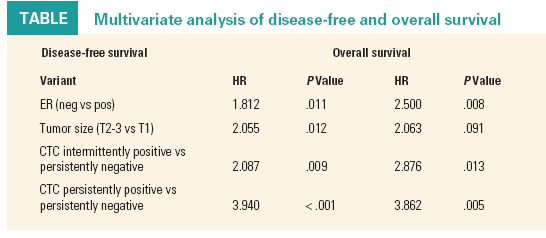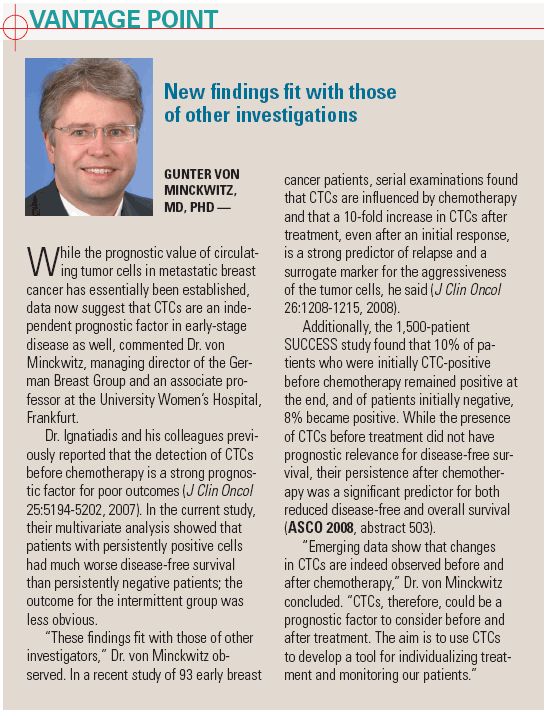Persistent circulating tumor cells predict worse outcomes in early breast cancer
The detection of cytokeratin 19-positive/HER2-positive circulating tumor cells in early breast cancer patients both before and after adjuvant chemotherapy predicts extremely poor outcomes, according to European investigators.
The detection of cytokeratin 19-positive/HER2-positive circulating tumor cells in early breast cancer patients both before and after adjuvant chemotherapy predicts extremely poor outcomes, according to European investigators.
Michail Ignatiadis, MD, PhD, of the Jules Bordet Institute, Brussels, Belgium, reported that patients with persistently positive CTC findings had nearly a fourfold increased risk for relapse and death, compared to persistently negative patients. The monitoring of CTCs may someday serve as an early indicator of successful treatment for early breast cancer, he said. While Dr. Ignatiadis’ team used a molecular-based RT-PCR assay to evaluate CTCs, other investigators have used the immunofluorescence-based CellSearch System (ASCO 2008, abstract 503; N Engl J Med 351:781-791, 2004).

“We found that CTCs detected in early breast cancer patients, using our molecular technique, have independent prognostic value beyond all known tumor characteristics,” Dr. Ignatiadis reported (ESMO 2008 abstract 187PD).
The study included 400 patients with stage I-III breast cancer treated with adjuvant chemotherapy, without trastuzumab (Herceptin). Before and after chemotherapy, the researchers used real-time and nested RT-PCR to detect cells in the peripheral blood that were positive for cytokeratin 19 (CK19) mRNA and HER2 mRNA. Based on CTC monitoring, patients were classified as follows:
• Persistently negative: CK19-negative and HER2-negative both before and after chemotherapy (n = 181).
• Intermittently positive: CK19-positive or HER2-positive before or after chemotherapy (n = 166).
•Persistently positive: CK19-positive and HER2-positive both before and after chemotherapy (n = 53).

At a median follow-up of 56 months, a multivariate analysis of potential prognostic factors found significant differences among the groups according to CTC status (see Table). CTC status, in fact, was more predictive than ER status or tumor size. Among the 181 patients predicted to have a good prognosis, there were only 26 relapses and 8 deaths. Among the 53 with a poor prognosis, there were 25 relapses and 12 deaths. The 166 intermediate-risk patients experienced 37 relapses and 33 deaths.
Dr. Ignatiadis said he is confident that the CK19-positive cells are tumor cells, based on the observation that all CK19-positive cells had chromosomal alterations on additional FISH testing. He acknowledged that since CK19 is an epithelial marker, it may also be detected in the absence of cancer. “Two of 100 healthy controls were positive for CK19, for a 2% false-positive rate, which is the same as that seen with the CellSearch method,” he said.
The strength of these findings is based on the assay’s high sensitivity and the maturity of the data (five years of follow up), though a larger study is called for, Dr. Ignatiadis said.